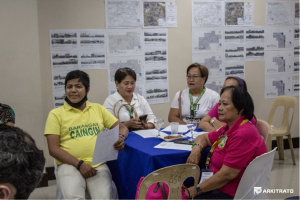The Value of Civic Participation and Institutional Partnerships
by Noel Cruz

PHOTO: From Left: Ar. Leah Dela Rosa (Newton UST Team Lead),
Ar. Rodolfo Ventura (Dean of UST College of Architecture) and Mayor Dan Fernandez (Mayor of Santa Rosa City)
From my personal experiences of working for the MESA project and talking with local residents from the City of Santa Rosa, I have witnessed firsthand how local participation is of great importance in addressing the real and urgent needs and aspirations of a society.

PHOTO: Some of the community representatives
The concept of civic participation is said to be closely linked with the concept of democracy. Although the concept of democracy is not new, in the Philippine context, it is only in recent decades that “bottom-up” approaches to development, which incorporate local opinion in decision-making, have become popular. After six months of working with some of the local residents of the City of Santa Rosa, we came to reap the first fruits of our collaboration with them during the first Local Advisory Council meeting on January 7, 2019. It was attended by 14 local representatives from the different barangays of Santa Rosa, as well local professional counterparts, the local planning office and the Newton research teams of the University of Santo Tomas and the University of Reading. Highlights of the meeting were the presentations of milestones achieved during the research and the personal sharing of all the local representatives. It is heart-warming to hear some of them say how the Newton research has become a venue for them to become more knowledgeable of their society, making them feel empowered and more engaged. During their sharing, it is interesting to note how the various barangays with different ecological profiles share the same needs and aspirations. Two of the most common are the need for an ‘ecopark’(green space for recreation and relaxation) and a proper waste water management system that could hopefully reduce flooding. The meeting ended with the sharing of positive and hopeful insights from both the UST and UoR research delegations.

PHOTO: Group photo of LAC participants including 14 community representatives,
city planning representatives and the UST and UoR research teams
Overall, my experiences so far from this research has given me a deeper understanding of my responsibilities as a professional in assisting communities. It is humbling to learn of how third party institutions such as universities can help in bridging gaps between the government and the local communities in identifying and solving local issues as well as developing new strategies and policies that will promote a more livable and sustainable society.
